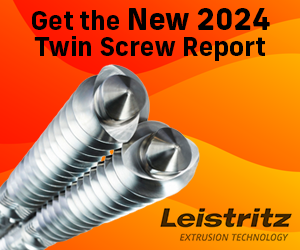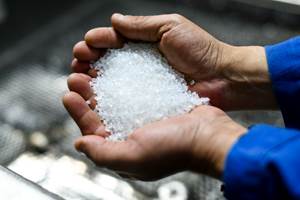Working with Color Concentrates
Perhaps the greatest difficulty involving the use of color concentrates is specifying them appropriately for the material to which they are being added.
Perhaps the greatest difficulty involving the use of color concentrates is specifying them appropriately for the material to which they are being added. In addition to the obvious requirement of matching the desired color without using ingredients that will be potentially damaging to the polymer, there are two key components of this specification that are very often not even dictated by the company purchasing the color concentrate. These are the composition and molecular weight of the carrier resin used to produce the concentrate. The mixture of ingredients that makes up a colorant typically constitutes 30% to 50% of a pelletized color concentrate. The remainder is a polymer system known as a carrier resin that essentially is a binder for the colorant.
Concentrates are usually added to the base resin at levels of 2 to 5 lb per 100 lb of the natural material. Consequently, assuming that the concentrate is mixed correctly, the carrier polymer can constitute from 1% to 3% or more of the final compound. This makes it the largest component in the additive package and therefore its selection requires some attention to detail. Specifically, the carrier resin should be chemically compatible with the base resin. The best way to ensure this is to make the color concentrate from the same type of polymer as the base resin to which it is being added.
Welcome! You’ve unlocked premium content.
There is some latitude in these rules. For example, a nylon 6 carrier can be used in coloring a nylon 66 or 46. These nylons are compatible and the lower melting point of the nylon 6 promotes good mixing. The same thing is true for acetal copolymer carriers in an acetal homopolymer. SAN serves as a compatible carrier for ABS (although polystyrene does not). And a blend can utilize a color concentrate based on one of the two polymers in the blend.
A molder who understands that using an incompatible carrier resin is essentially orchestrating contamination into the manufacturing process will instruct the concentrate manufacturer to employ a compatible carrier. But many are focused on matching the color specified by their customer at the lowest cost. And one way to do this is to employ a low-cost polymer such as polyethylene or an ethylene copolymer such as EVA as the carrier resin. This decision may be made by the concentrate manufacturer without the knowledge of the end user or the molder. Some concentrate suppliers used to distinguished themselves from their competitors by always formulating their concentrates using compatible carriers. But even many of these suppliers, in an effort to compete on price, have introduced lower-cost alternates based on so-called “universal carriers.”
But there is no such thing. Contamination by any other name is still contamination. If a molder were to find polyethylene pellets in a drum of ABS or polycarbonate, he would likely discard it or pick out the offending material. But every day, molders add color concentrates that introduce contamination to their base resins, perhaps assuming that any material will tolerate a small amount of something foreign and still perform to expectations.
Material suppliers that provide so-called “salt and pepper” mixtures have also been known to add incompatible materials to their own products. One major supplier of nylon 66 compounds employs nylon 6 as a carrier in some of its salt-and-pepper mixtures, but uses EVA in others. Unfortunately, the vinyl acetate in EVA begins to thermally degrade at typical nylon 66 processing temperatures, producing a waxy byproduct that causes screw slippage as well as cosmetic problems, particularly near gates and at weld lines.
Even a commodity material such as polypropylene can be negatively affected by the use of incompatible carriers in colorants. Many years ago we ran a line of tops for spice containers that contained multiple living hinges. In some colors the parts ran without any trouble and the hinges performed well. In other colors the hinges tended to release poorly from the mold and those that did broke after just a few flex cycles. The difference in performance was not the colorants but the carrier resins in the concentrates, and when this was corrected the processing and performance problems disappeared.
Assuming that the carrier resin is compatible with the base resin, the second important property is the molecular weight of that carrier, usually expressed in terms of melt flow rate (MFR). Typically, concentrate formulators will select a carrier with a higher MFR than the base resin that is being colored in order to promote good mixing. A polycarbonate with a nominal MFR of 10 g/10 min may employ concentrates with MFRs in the range of 20 to 30. The higher-MFR concentrate will ideally flow more readily once it is in the screw and will be more easily distributed through the mass of natural-colored material.
But this approach is often taken to extremes that do more harm than good. Sometimes the connection between MFR and molecular weight is ignored. It is molecular weight, after all, that drives performance. The higher the MFR of the carrier resin, the more likely it is that the final product will exhibit reduced performance in the final molded part.
We encountered this problem with polycarbonate parts that were cracking in the field just a few months after installation. When we tested the MFR of the base resin and the molded parts, the difference between the two showed clear signs of polymer degradation, and an evaluation of the process showed problems with drying. However, even after the drying problems were resolved, the material still showed a tendency to degrade under normal processing conditions.
The table shows the behavior of the material with and without colorant. An MFR increase of 20% is typical of good processing and the resulting part should perform in a manner consistent with the properties of the polymer. An increase of 49% is considered to represent the initial stages of polymer degradation, and while the part may look good and initially perform as expected, the mean lifetime of the part under demanding conditions will be shorter.
The data show that the problem is not with the process but with the concentrate. When the blue concentrate was tested by itself the MFR was 90 g/10 min. I have seen polycarbonate concentrates with MFRs as high as 140. This is just another form of contamination, not in resin composition but in molecular weight.
There is a reason behind all of this. The general-purpose screws in most molding machines today do a very poor job of creating a homogeneous melt. This lack of homogeneity is always a factor, but when color concentrates are used it becomes visible. Reliance on low-melting-point and high-MFR carrier resins represents the attempt of the concentrate formulators to compensate for this lack of mixing within the processing equipment. It represents a misplaced emphasis. In the next issue we will discuss the root of the mixing problem and how to address it head on.
Related Content
Commodity Resin Prices Flat to Lower
Major price correction looms for PP, and lower prices are projected for PE, PS, PVC and PET.
Read MoreThe Effects of Stress on Polymers
Previously we have discussed the effects of temperature and time on the long-term behavior of polymers. Now let's take a look at stress.
Read MoreLanxess and DSM Engineering Materials Venture Launched as ‘Envalior’
This new global engineering materials contender combines Lanxess’ high-performance materials business with DSM’s engineering materials business.
Read MorePrices for All Volume Resins Head Down at End of 2023
Flat-to-downward trajectory for at least this month.
Read MoreRead Next
Lead the Conversation, Change the Conversation
Coverage of single-use plastics can be both misleading and demoralizing. Here are 10 tips for changing the perception of the plastics industry at your company and in your community.
Read MoreMaking the Circular Economy a Reality
Driven by brand owner demands and new worldwide legislation, the entire supply chain is working toward the shift to circularity, with some evidence the circular economy has already begun.
Read MoreBeyond Prototypes: 8 Ways the Plastics Industry Is Using 3D Printing
Plastics processors are finding applications for 3D printing around the plant and across the supply chain. Here are 8 examples to look for at NPE2024.
Read More
.jpg;width=70;height=70;mode=crop)





















